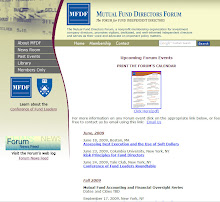Lori Richards, Director of the SEC's Office of Compliance Inspections and Examinations, addressed the ICI's Securities Law Development Conference on December 16, and shared her thoughts on how SEC oversight of mutual funds might be improved by the greater use of technology and data analysis.
Richards pointed out that the great increase in the number of advisers and funds caused OCIE switched to a risk-based approach designed to scrutinize those funds, advisers and issues that appear to present the greatest potential for having an adverse effect on investors. Richards also stressed that establishing and maintaining an effective risk-based oversight program requires active surveillance utilizing timely and continuing access to a set of reliable information about each firm under surveillance to be able to gauge the relative compliance risk, and to monitor changes to these risk profiles over time.
At the present, most SEC filings by mutual funds, like Form N-SAR, are in an unstructured, text-based format, lack certain portfolio-level identifying information, and are not timely enough to provide the data needed for a robust surveillance program. To implement an effective surveillance program for the fund industry, Richards listed general fund-level information she thinks should be filed in a meaningful and searchable format useable by OCIE's staff:
Given easy access to this fund specific data, Richards said that the OCIE staff could perform electronically a number of analyses now only performed during routine on-site inspections, potentially identifying, for example, indications of mispricing, valuation anomalies, liquidity concerns, deviations from investment objectives and risk-taking beyond that which was disclosed.
Richards indicated that the kind of data she envisions could be XML-based, like the Commission's current Interactive Data initiatives, and either may be integrated into the SEC's EDGAR system or set up externally. Because such a system would require Commission rulemaking, or even legislation, Ms. Richards aksed for the cooperation of the Commission and the industry in making the system she envisions possible.
Given the demographics in the mutual fund industry in recent years — the number of advisers that operate a mutual fund, the dollars managed by mutual funds, and the number of investors who rely on mutual funds as their primary investment vehicle — as well as recent portfolio losses -- it is more critical now than ever that the SEC provide sound oversight. We have identified ways in which our oversight of mutual funds could be improved, and I wanted to share these ideas with you today.
Richards pointed out that the great increase in the number of advisers and funds caused OCIE switched to a risk-based approach designed to scrutinize those funds, advisers and issues that appear to present the greatest potential for having an adverse effect on investors. Richards also stressed that establishing and maintaining an effective risk-based oversight program requires active surveillance utilizing timely and continuing access to a set of reliable information about each firm under surveillance to be able to gauge the relative compliance risk, and to monitor changes to these risk profiles over time.
Potentially, such a surveillance system might seek to identify indications of things like mispricing, liquidity concerns, lack of diversification, and deviations from stated investment objectives. With respect to money market funds, such a system might seek to identify funds that hold securities in troubled issuers and those that may be at risk of breaking a dollar.
. . .
[C]reating a surveillance function would provide certain benefits of efficiency to mutual funds and to the SEC staff. If we were to routinely surveil key data, we would be able to better evaluate certain risks being assumed by mutual funds and could reduce the time spent doing this work during exams. In addition, with data already available, we'd be able to narrow in and focus our examinations on particular funds and particular issues.
At the present, most SEC filings by mutual funds, like Form N-SAR, are in an unstructured, text-based format, lack certain portfolio-level identifying information, and are not timely enough to provide the data needed for a robust surveillance program. To implement an effective surveillance program for the fund industry, Richards listed general fund-level information she thinks should be filed in a meaningful and searchable format useable by OCIE's staff:
- NAV per share;
- the shadow price for money market funds; the total net assets and shares outstanding;
- percentage of the portfolio that is fair valued; percentage of the portfolio that is illiquid;
- a description of each share class and the primary investment objective or style of the fund.
Given easy access to this fund specific data, Richards said that the OCIE staff could perform electronically a number of analyses now only performed during routine on-site inspections, potentially identifying, for example, indications of mispricing, valuation anomalies, liquidity concerns, deviations from investment objectives and risk-taking beyond that which was disclosed.
Richards indicated that the kind of data she envisions could be XML-based, like the Commission's current Interactive Data initiatives, and either may be integrated into the SEC's EDGAR system or set up externally. Because such a system would require Commission rulemaking, or even legislation, Ms. Richards aksed for the cooperation of the Commission and the industry in making the system she envisions possible.
I hope that the SEC staff and the fund industry will work together to further explore the ideas I have described this morning, based on our shared commitment to seek the greatest level of investor protection.The full text of Ms. Richards' address is avaiable at: http://www.sec.gov/news/speech/2008/spch121608lar.htm





